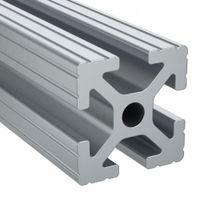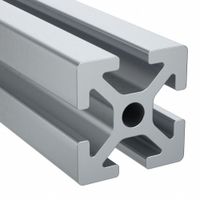Call +(254) 703 030 000 / 751 483 999 / 721 704 777
- Home
- Material Handling
- Structural Framing Systems
- T Slot Framing Systems
- Profiles For T Slot Framing
.....Read More
Frequently Asked Questions
What are T-slot framing profiles used for?
T-slot framing profiles are versatile structural components used in various applications due to their modularity and ease of assembly. They are primarily used in the construction of custom industrial and commercial frameworks. Here are some common uses:
1. **Machine Guards and Safety Enclosures**: T-slot profiles are often used to build protective barriers around machinery to ensure operator safety and prevent accidents.
2. **Workstations and Benches**: They are used to construct ergonomic workstations and benches that can be easily reconfigured to suit different tasks or processes.
3. **Conveyor Systems**: T-slot profiles provide a flexible framework for building conveyor systems, allowing for easy adjustments and modifications.
4. **Automation Equipment**: In automation, T-slot profiles are used to create frames for robotic arms, assembly lines, and other automated systems.
5. **Exhibition Stands and Displays**: Their modular nature makes them ideal for constructing exhibition stands and displays that can be easily assembled, disassembled, and transported.
6. **3D Printers and CNC Machines**: T-slot profiles are commonly used in the construction of 3D printers and CNC machines due to their precision and stability.
7. **Shelving and Storage Solutions**: They are used to build custom shelving units and storage solutions that can be tailored to specific needs.
8. **Laboratory and Cleanroom Equipment**: T-slot profiles are used to construct frames for laboratory equipment and cleanroom environments, where flexibility and cleanliness are crucial.
9. **Vehicle and Aerospace Applications**: They are used in the construction of lightweight frames and structures in vehicles and aerospace applications.
10. **DIY Projects**: Hobbyists and DIY enthusiasts use T-slot profiles for various projects due to their ease of use and adaptability.
Overall, T-slot framing profiles offer a flexible, reusable, and cost-effective solution for constructing a wide range of structures and systems.
How do you connect T-slot profiles?
To connect T-slot profiles, follow these steps:
1. **Select the Right Connectors**: Choose from various connectors like corner brackets, joining plates, or gussets based on the application and load requirements.
2. **Cut Profiles to Length**: Use a saw to cut the T-slot profiles to the desired length, ensuring clean, straight cuts for a proper fit.
3. **Prepare the Profiles**: Deburr the cut edges to remove any sharpness and ensure smooth assembly.
4. **Align the Profiles**: Position the profiles in the desired configuration, ensuring the T-slots are aligned for easy insertion of connectors.
5. **Insert T-Nuts**: Slide T-nuts into the T-slots of the profiles. These nuts will hold the connectors in place. Choose the appropriate size and type of T-nut for your profile.
6. **Attach Connectors**: Position the chosen connectors (e.g., corner brackets) at the joints where the profiles meet. Align the holes in the connectors with the T-nuts.
7. **Secure with Fasteners**: Use bolts or screws to fasten the connectors to the T-nuts. Tighten them using a wrench or Allen key, ensuring a secure connection.
8. **Check Alignment**: Ensure all profiles are aligned correctly and adjust if necessary before fully tightening the fasteners.
9. **Add End Caps**: Optionally, attach end caps to the open ends of the profiles for a finished look and to prevent debris from entering the slots.
10. **Test the Assembly**: Check the stability and strength of the assembled structure to ensure it meets the required specifications.
By following these steps, you can effectively connect T-slot profiles to create a sturdy and versatile framework for various applications.
What are the benefits of using T-slot framing?
T-slot framing offers several benefits:
1. **Versatility**: T-slot framing systems are highly adaptable, allowing for easy assembly and reconfiguration. Components can be added, removed, or adjusted without the need for welding or specialized tools.
2. **Ease of Assembly**: The modular nature of T-slot framing means that structures can be assembled quickly and efficiently. The use of standard connectors and fasteners simplifies the process, reducing labor costs and time.
3. **Customization**: T-slot profiles can be cut to any length and combined in various configurations, enabling custom solutions tailored to specific needs. This flexibility is ideal for prototyping and custom projects.
4. **Strength and Durability**: Made from materials like aluminum, T-slot frames are strong yet lightweight. They offer excellent resistance to corrosion and wear, making them suitable for a wide range of environments.
5. **Cost-Effectiveness**: The reusability and modularity of T-slot systems can lead to cost savings over time. Components can be reused in different projects, reducing the need for new materials.
6. **Aesthetic Appeal**: T-slot framing provides a clean, professional look, which is beneficial for applications where appearance is important, such as trade show displays or retail fixtures.
7. **Compatibility with Accessories**: A wide range of accessories, such as panels, doors, and brackets, can be easily integrated into T-slot systems, enhancing functionality and design possibilities.
8. **Safety**: The smooth edges and rounded corners of T-slot profiles reduce the risk of injury during assembly and use, making them safer than traditional metal framing options.
9. **Environmental Impact**: Aluminum T-slot framing is recyclable, contributing to sustainability efforts and reducing environmental impact.
These benefits make T-slot framing a popular choice in industries such as manufacturing, automation, and construction.
Can T-slot profiles be reconfigured easily?
Yes, T-slot profiles can be reconfigured easily. T-slot aluminum profiles are designed for modularity and flexibility, making them ideal for projects that require frequent adjustments or reconfigurations. The T-slot design allows for easy assembly and disassembly without the need for welding or specialized tools. Components can be added, removed, or repositioned by simply loosening the fasteners, sliding the profiles into the desired position, and retightening the fasteners. This ease of reconfiguration is facilitated by the use of standard connectors, brackets, and fasteners that fit into the T-slots, allowing for a wide range of configurations and applications. The profiles can be cut to size and combined with various accessories to create custom structures, and their lightweight yet strong construction makes them suitable for both temporary and permanent installations. This adaptability makes T-slot profiles a popular choice in industries such as manufacturing, automation, and DIY projects, where the ability to quickly modify or expand structures is often required.
What materials are T-slot profiles made from?
T-slot profiles are primarily made from aluminum, specifically aluminum alloys such as 6061-T6 or 6063-T5. These alloys are favored for their excellent strength-to-weight ratio, corrosion resistance, and ease of machining. Aluminum T-slot profiles are anodized to enhance surface hardness and provide additional corrosion resistance, making them suitable for various industrial applications.
In addition to aluminum, T-slot profiles can also be made from other materials, though less commonly. Steel T-slot profiles are used when higher strength and rigidity are required. These are typically made from carbon steel or stainless steel, offering superior load-bearing capacity and durability. However, they are heavier and may require protective coatings to prevent rust.
Plastic T-slot profiles, often made from materials like PVC or polycarbonate, are used in applications where weight reduction, electrical insulation, or chemical resistance is necessary. These profiles are not as strong as metal ones but offer advantages in specific environments, such as clean rooms or corrosive settings.
Composite materials, including fiberglass-reinforced plastics, are also used for T-slot profiles in specialized applications. These materials provide a balance of strength, weight, and resistance to environmental factors, making them suitable for niche uses.
Overall, the choice of material for T-slot profiles depends on the specific requirements of the application, including factors like load capacity, environmental conditions, and cost considerations.
How do you choose the right T-slot profile size?
To choose the right T-slot profile size, consider the following factors:
1. **Load Requirements**: Determine the maximum load the structure will bear. Larger profiles can support heavier loads, while smaller ones are suitable for lighter applications.
2. **Application Type**: Identify the specific application, such as machine frames, workstations, or enclosures. Different applications may have unique requirements influencing profile size.
3. **Environmental Conditions**: Consider the environment where the profile will be used. Harsh conditions may require more robust profiles with corrosion-resistant finishes.
4. **Connection and Compatibility**: Ensure the profile size is compatible with existing systems or components. Check for standardization in connectors and accessories.
5. **Deflection and Rigidity**: Calculate the deflection under load to ensure the profile maintains structural integrity. Larger profiles generally offer greater rigidity.
6. **Space Constraints**: Evaluate the available space for installation. Choose a profile size that fits within spatial limitations without compromising functionality.
7. **Cost Considerations**: Balance the cost with performance needs. Larger profiles are typically more expensive, so select the smallest size that meets all requirements.
8. **Ease of Assembly**: Consider the ease of assembly and disassembly. Some profiles offer modularity and flexibility, which can be beneficial for future modifications.
9. **Supplier Recommendations**: Consult with suppliers or manufacturers for guidance based on their expertise and product offerings.
10. **Safety Standards**: Ensure compliance with relevant safety standards and regulations, which may dictate specific profile sizes for certain applications.
By evaluating these factors, you can select the appropriate T-slot profile size that meets your structural, functional, and budgetary needs.
Are T-slot profiles compatible with other systems?
T-slot profiles are generally compatible with other systems, but compatibility depends on several factors. T-slot profiles, often made from aluminum, are used in modular framing systems for constructing frameworks, enclosures, and machinery. They are designed with a T-shaped groove that allows for easy assembly and reconfiguration using connectors and fasteners.
1. **Standardization**: T-slot profiles come in various standards, such as metric (e.g., 20mm, 30mm) and imperial (e.g., 1 inch, 1.5 inches). Compatibility with other systems depends on matching these standards. Profiles from different manufacturers may have slight variations, so it's crucial to ensure that the dimensions and slot sizes match.
2. **Connectors and Fasteners**: The compatibility of T-slot profiles with other systems also depends on the availability of compatible connectors and fasteners. Many manufacturers offer a range of accessories designed to work with their specific profiles, but third-party connectors can sometimes bridge different systems.
3. **Cross-Brand Compatibility**: Some brands design their T-slot profiles to be compatible with those of other manufacturers, but this is not universal. Checking the specifications and testing for fit is advisable when mixing brands.
4. **Adaptation**: If direct compatibility is not possible, adapters or custom machining can be used to connect T-slot profiles with other systems. This may involve drilling, tapping, or using specialized brackets.
5. **Application Requirements**: The intended application may dictate compatibility. For structural applications, ensuring that the profiles and connectors meet the required load-bearing and safety standards is essential.
In summary, while T-slot profiles can be compatible with other systems, careful consideration of standards, connectors, and application requirements is necessary to ensure a successful integration.

